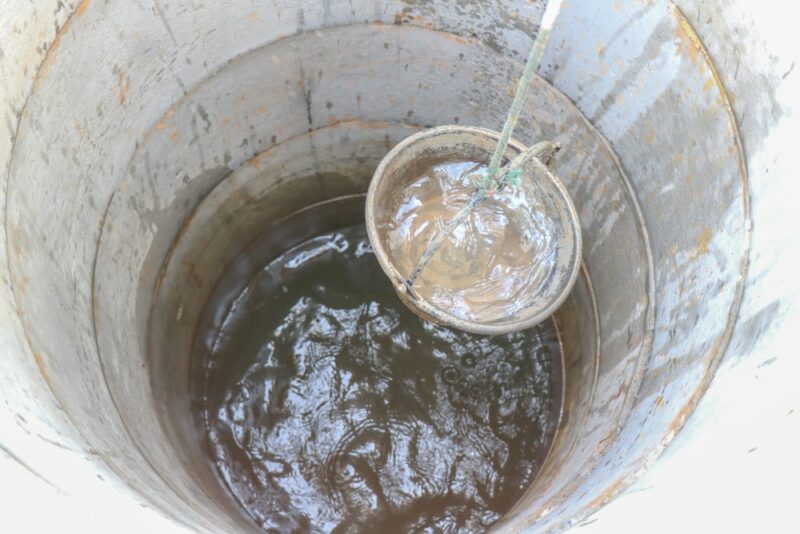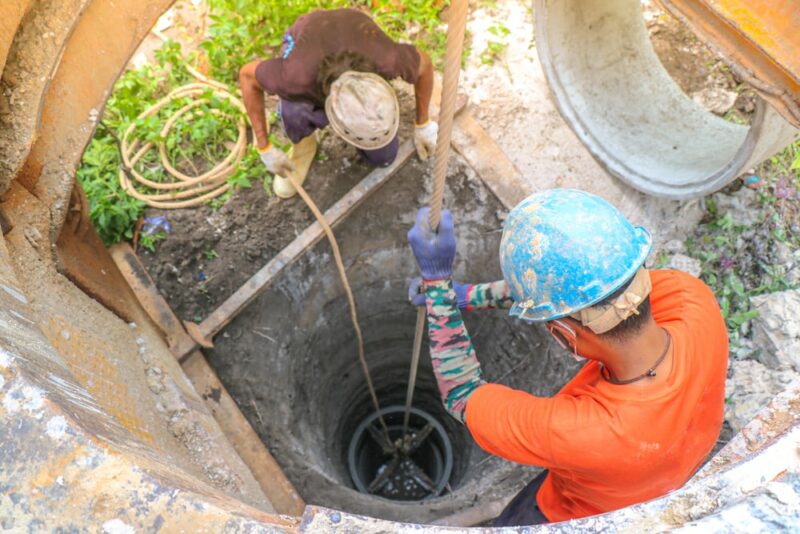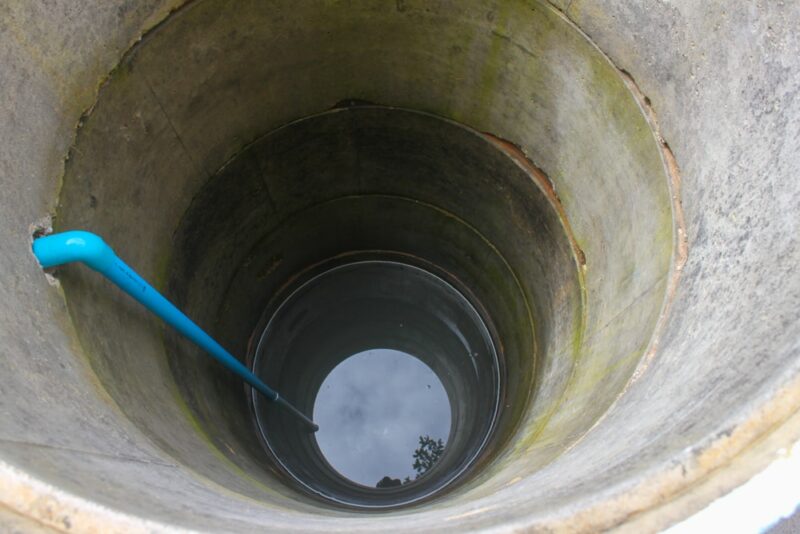How Does a Well Work? Facts & FAQ
-
Pete Ortiz
- Last updated:

A well is an artificial hole or shaft dug in the ground to access groundwater. Wells provide easy access to a reliable source of clean, potable water and can be a great solution for those in rural areas or locations far away from municipal water sources.
Knowing how a water well works can help you better understand how groundwater is accessed and utilized, as well as the pros and cons of using a well as opposed to other water sources.
How Does It Work?
When a well is dug, the process creates an area where groundwater can accumulate. The aquifer—an underground rock, sand, or gravel layer—holds groundwater and allows it to filter through natural layers of soil and bedrock.
Depending on the depth at which the well is dug, you can access water from different depths. Generally speaking, the deeper a well is dug, the more water there will be available.
In many wells, a pump is installed to draw out the water from the aquifer and transport it into the home or other buildings. The type of pump used depends on several factors, including the depth of the well and whether or not electricity is available in the area. Submersible pumps, for example, are used in deeper wells, while shallow-well pumps are used for less than 25 feet deep.
Once water is drawn up from the well, it is typically filtered and treated before being used. This can include purifying the water with a UV filter or chemical disinfection to remove bacteria and other contaminants. Once the water is treated, you can use it for drinking, cooking, cleaning, and other household tasks.
You must also maintain wells regularly to ensure that they are producing clean, safe water. This includes inspecting the well system periodically and testing the water quality regularly to ensure there are no contamination or other issues.
It is important to remember that wells are not always the most reliable source of water and can sometimes be susceptible to contamination from nearby sources such as septic systems or runoff from agricultural areas.
Therefore, regular maintenance and water testing are highly recommended for any well system to safeguard against potential health risks.

What Are the Different Types of Wells?
There are several different types of wells that can be used to access groundwater. The type of water well chosen typically depends on the area and purpose for which it will be used.
The following are some of the most common types:
1. Dug Well
A dug well is a shallow hole that is sometimes lined with bricks or stones. These wells can range in depth from a few feet to up to 60 feet deep and are often used for shallow water tables or areas with little bedrock.
2. Driven Well
A driven well is created by driving a pipe into the ground, typically through soils and sand layers. The pipe is then filled with gravel or stone to create a filter for the water. This type of well is typically used in areas where there are only shallow aquifers or limited bedrock.
3. Bored Well
A bored well is created by drilling into the ground using an auger or other rotary tool. These wells can reach depths of up to 200 feet and are often used to access deeper aquifers.
4. Cased Well
Similar to a bored well, cased wells feature the addition of a pipe or casing. Either is installed around the borehole to prevent contamination and increase water flow. These wells are typically used in areas where there may be contamination issues due to surface runoff and other sources.
Understanding the different types of water wells available is essential for anyone looking to use groundwater as their water source.
Where Is It Used?
A water well is typically used in areas where surface water is not available or easily accessible, such as in rural areas or in locations with limited access to public water systems.
They can also be used in areas where there are shallow aquifers and limited bedrock, as well as for irrigation purposes. In these cases, the well can provide a reliable source of clean, safe drinking water for the area.
Regardless of where it is used, a well can provide an efficient and cost-effective source of water for those living in remote or rural locations. It is important to remember that wells must be properly maintained and monitored regularly to ensure they continue to produce safe, clean water over time.
Advantages of Water Wells
Water wells offer a number of benefits for those who choose to access groundwater as a source of drinking water.
- The most obvious advantage is that well water does not have to be purchased or treated like municipal drinking water, which may contain contaminants and require post-treatment. Also, if an individual has the resources and knowledge, they can easily monitor the water quality of their own water well, ensuring that it meets the standards they deem necessary.
- Another advantage is that wells can often go deeper than municipal water sources, providing access to a larger underground reservoir of potable water. This makes them particularly useful in areas where drought or other conditions strain an area’s available surface water resources.
- Water wells also have the advantage of providing a reliable source of water during times of emergency or natural disaster, when surface sources may become contaminated or otherwise unusable.
- Finally, well water is often considered to be of higher quality than municipal drinking water sources due to its lack of exposure to air and other environmental contaminants that can degrade the quality of surface water sources.
Disadvantages of Water Wells
While there are many benefits to using a water well, it is important to note that there can also be some drawbacks.
- The most obvious disadvantage is the cost associated with drilling and maintaining a water well. Depending on local regulations, the depth of the well, and other factors, this can range from hundreds to thousands of dollars. Additionally, regular maintenance of the well is important in order to ensure that the water remains safe for drinking and other uses.
- In some cases, wells can also be susceptible to contamination from nearby land or agricultural activities, such as manure spreading or fertilizer use. What’s more, the shallow depth in some wells can become contaminated from runoff during heavy rains or flooding or from seepage from nearby landfills and sewage treatment facilities.
- Lastly, wells are not always a feasible solution in areas with high water tables or hard rock formations, as the cost of drilling can be prohibitively expensive.

Frequently Asked Questions (FAQs)
How deep is a typical water well?
The depth of a water well can vary significantly depending on the local conditions, but most wells range between 20 and 200 feet deep.
Can I use my water well for irrigation purposes?
Yes, in many cases, it is possible to use your water well to irrigate your garden or lawn. However, be sure to check with your local authorities first to ensure that there are no restrictions in place.
How often should I have my water well tested for contamination?
Generally speaking, it is recommended to have your water well tested at least once per year by a qualified professional. However, depending on local regulations and other factors, more frequent testing may be required.
What kind of maintenance does a water well require?
Regular maintenance is important to ensure that your well remains in good working condition and continues to provide safe drinking water. This includes checking the pump and pressure tank—as well as any other associated components—for signs of damage or wear and tear.
Conclusion
Water wells can provide a reliable source of clean drinking water for those living in rural or remote areas. However, it is important to consider all the potential pros and cons before deciding whether this is the right option for your specific needs.
If you do decide to pursue a well, be sure to research local regulations and contact an experienced drilling contractor to ensure that the process is completed safely and correctly.
Featured Image Credit: I am a Stranger, Shutterstock
Contents





